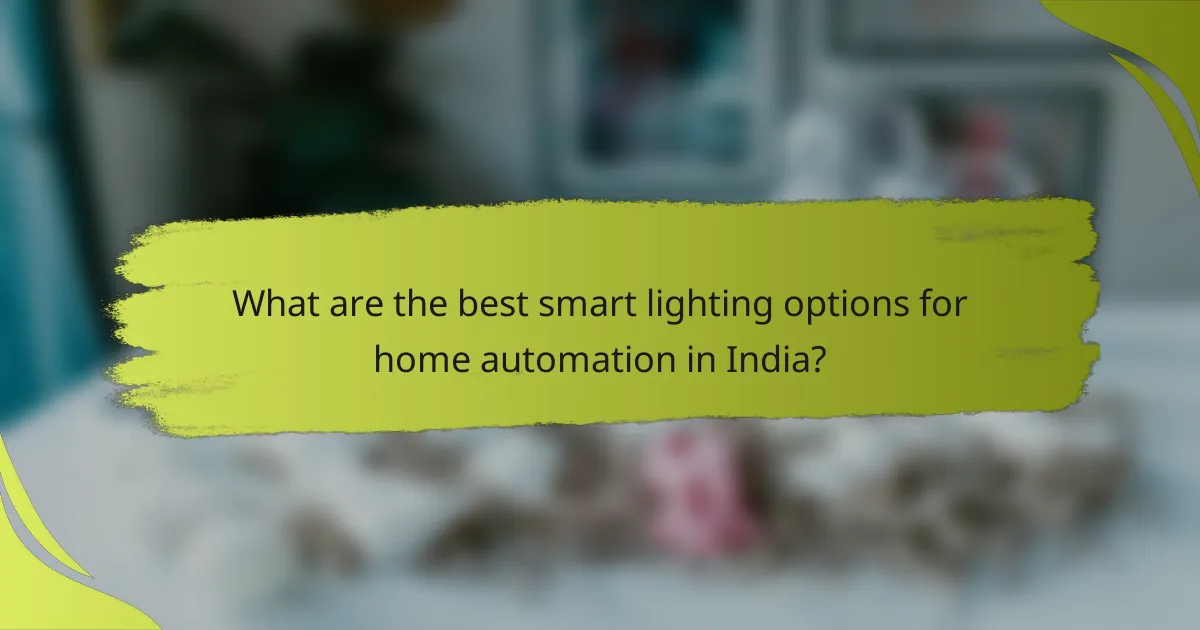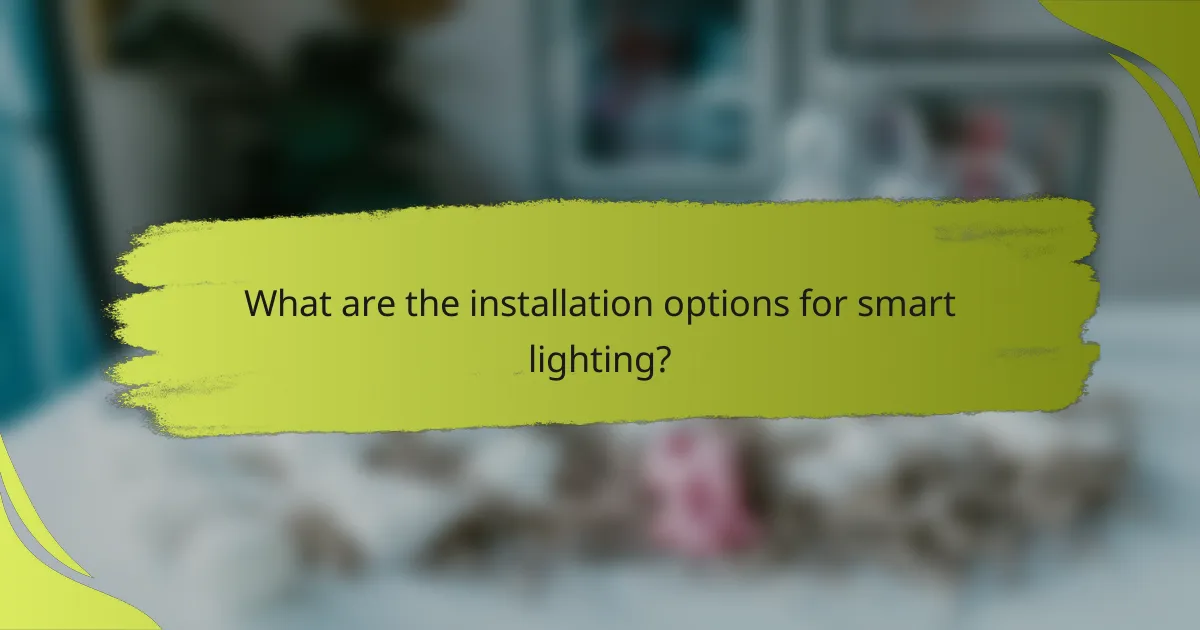As home automation continues to evolve, smart lighting options have emerged as a popular choice for enhancing convenience and energy efficiency. In India, products like Philips Hue, Wipro Smart LED, and TP-Link Kasa Smart Bulbs offer a variety of features that cater to different needs and preferences. These systems allow users to control their lights remotely, providing a seamless integration into modern smart home environments.

What are the best smart lighting options for home automation in India?
The best smart lighting options for home automation in India include Philips Hue, Wipro Smart LED, Syska Smart LED, TP-Link Kasa Smart Bulbs, and Amazon Echo Glow. These products offer a range of features, compatibility with various smart home systems, and user-friendly controls, making them ideal for enhancing convenience and energy efficiency in Indian households.
Philips Hue
Philips Hue is a leading smart lighting solution known for its extensive range of bulbs and fixtures. These lights can be controlled via a smartphone app or voice commands through smart assistants like Alexa and Google Assistant. Users can customize colors, set schedules, and create scenes to match their mood or activities.
Consider the Philips Hue Bridge for full functionality, allowing you to connect multiple bulbs and control them seamlessly. The initial investment may be higher, but the versatility and quality make it a worthwhile choice for serious home automation enthusiasts.
Wipro Smart LED
Wipro Smart LED bulbs provide a budget-friendly option for smart lighting in India. These bulbs can be controlled through a mobile app and are compatible with voice assistants. They offer features like dimming and color changing, making them suitable for various settings.
Wipro’s products are designed to be energy-efficient, helping to reduce electricity bills. They are a great choice for those looking to dip their toes into smart lighting without a significant financial commitment.
Syska Smart LED
Syska Smart LED bulbs are another popular choice in the Indian market, offering a balance of affordability and functionality. They can be easily integrated with smart home systems and controlled via a dedicated app or voice commands.
With features like scheduling, dimming, and color options, Syska bulbs cater to diverse lighting needs. Their energy efficiency also contributes to lower energy consumption, making them an eco-friendly option.
TP-Link Kasa Smart Bulbs
TP-Link Kasa Smart Bulbs are known for their reliability and ease of use. These bulbs can be controlled through the Kasa app, allowing users to manage their lighting from anywhere. They support voice control with popular smart assistants, enhancing convenience.
These bulbs offer a variety of features, including scheduling and scene creation. They are a solid option for those looking to integrate smart lighting into their existing Kasa smart home ecosystem.
Amazon Echo Glow
Amazon Echo Glow is a unique smart lighting option that doubles as a night light and can be controlled through Alexa. It features color-changing capabilities and can be set to respond to voice commands, making it ideal for children’s rooms or as a decorative light.
This device can be paired with other Echo devices for synchronized lighting effects, adding a fun element to home automation. While it may not replace traditional bulbs, it serves as a versatile addition to a smart home setup.

How do smart lighting systems work?
Smart lighting systems operate through wireless technology, allowing users to control their lights remotely via mobile apps or voice commands. These systems typically connect to a home network, enabling automation and customization based on user preferences.
Wireless connectivity
Wireless connectivity is fundamental to smart lighting systems, as it allows devices to communicate without physical connections. Most systems use Wi-Fi, Zigbee, or Z-Wave protocols to connect bulbs and fixtures to a central hub or directly to your home network.
When selecting a smart lighting system, consider the range and compatibility of the wireless technology. For instance, Zigbee and Z-Wave are often more reliable for larger homes due to their mesh networking capabilities, while Wi-Fi may suffice for smaller spaces.
Mobile app control
Mobile app control is a key feature of smart lighting systems, enabling users to manage their lights from smartphones or tablets. These apps typically allow for scheduling, dimming, color changes, and scene setting, providing a high level of customization.
When choosing a system, check the app’s user interface and compatibility with your mobile device. Look for apps that offer intuitive controls and additional features like energy monitoring or integration with other smart home devices.
Voice assistant integration
Voice assistant integration enhances the convenience of smart lighting systems, allowing users to control lights using voice commands through devices like Amazon Alexa, Google Assistant, or Apple HomeKit. This feature enables hands-free operation and can be particularly useful for accessibility.
Ensure that the smart lighting system you choose is compatible with your preferred voice assistant. Some systems may offer more robust features or better performance with specific assistants, so consider your existing smart home ecosystem when making a decision.

What are the benefits of smart lighting?
Smart lighting offers enhanced convenience, energy savings, and improved security for homes. By integrating technology, users can control their lighting systems remotely, customize settings, and reduce energy consumption significantly.
Energy efficiency
Smart lighting systems are designed to optimize energy use, often leading to substantial savings on electricity bills. Many smart bulbs use LED technology, which consumes significantly less power than traditional incandescent bulbs, sometimes up to 80% less.
Additionally, features like motion sensors and timers ensure that lights are only on when needed. For example, you can set outdoor lights to turn on at dusk and off at dawn, minimizing unnecessary energy use.
Remote access
With smart lighting, you can control your lights from anywhere using a smartphone app or voice commands through a smart assistant. This remote access allows you to turn lights on or off, adjust brightness, or change colors even when you are away from home.
This feature enhances security by enabling you to simulate occupancy, making it appear as though someone is home. For instance, you can program lights to turn on at random times while you are on vacation.
Customizable settings
Smart lighting systems offer a high degree of customization, allowing users to create specific lighting scenes for different activities or moods. You can easily adjust brightness levels and colors to suit your preferences, whether for reading, entertaining, or relaxing.
Many systems also allow for automation based on schedules or triggers. For example, you can set your living room lights to gradually brighten in the morning to simulate a natural sunrise, promoting a more pleasant waking experience.

How to choose the right smart lighting system?
Choosing the right smart lighting system involves assessing compatibility with your existing devices, understanding budget constraints, and considering brand reputation. These factors will help ensure you select a system that meets your needs and integrates seamlessly into your home environment.
Compatibility with existing devices
When selecting a smart lighting system, check its compatibility with your current devices, such as smart home hubs, voice assistants, and other smart appliances. Systems that support popular protocols like Zigbee, Z-Wave, or Wi-Fi tend to offer broader compatibility.
For example, if you already use Amazon Alexa or Google Assistant, ensure the lighting system you choose can be controlled through these platforms. This will enhance your user experience and allow for more cohesive automation.
Budget considerations
Budget is a crucial factor when choosing a smart lighting system. Prices can vary widely, from basic smart bulbs costing around $10 to comprehensive systems that may exceed several hundred dollars. Determine how much you’re willing to invest and prioritize features that matter most to you.
Consider the long-term savings on energy bills that smart lighting can provide, as many systems offer energy-efficient options. Additionally, look for discounts or bundles that can help you save on initial costs.
Brand reputation
Brand reputation plays a significant role in the reliability and performance of smart lighting systems. Established brands often provide better customer support, more frequent updates, and higher quality products. Research customer reviews and ratings to gauge the experiences of other users.
Brands like Philips Hue, LIFX, and Wyze have built strong reputations in the smart lighting market. Choosing a reputable brand can help ensure that your investment is worthwhile and that you receive ongoing support for your system.

What are the installation options for smart lighting?
Smart lighting systems can be installed either by yourself or through professional services. Each option has its own advantages and considerations, depending on your technical skills and the complexity of the system.
DIY installation
DIY installation of smart lighting is a popular choice for tech-savvy homeowners looking to save on costs. Many smart lighting products come with user-friendly instructions and can be set up in a matter of hours.
When opting for DIY, consider the compatibility of your existing fixtures and the type of smart bulbs or systems you choose. Common options include smart bulbs that screw into standard sockets or smart switches that replace traditional light switches.
Be mindful of potential pitfalls, such as ensuring your Wi-Fi network is strong enough to support multiple devices. It’s also wise to check for any local electrical codes that may apply to your installation.
Professional installation services
Hiring professional installation services for smart lighting can provide a seamless experience, especially for complex setups. Professionals can ensure that all components are integrated correctly and functioning optimally.
This option is particularly beneficial for larger homes or for systems that require extensive wiring or configuration. Costs for professional installation can vary widely, typically ranging from a few hundred to over a thousand dollars, depending on the complexity of the project.
When selecting a service, look for licensed electricians with experience in smart home technology. This can help avoid issues related to safety and compliance with local regulations.

What are the common issues with smart lighting?
Smart lighting systems can face several common issues that affect their performance and user experience. Connectivity problems, compatibility issues, and security concerns are among the most prevalent challenges users encounter.
Connectivity problems
Connectivity problems are a frequent issue with smart lighting systems, often stemming from weak Wi-Fi signals or interference from other devices. These problems can lead to delayed responses or complete disconnection from the network, making it difficult to control lights remotely.
To mitigate connectivity issues, ensure that your smart lighting devices are within range of your router. Consider using a mesh Wi-Fi system to enhance coverage throughout your home, especially in larger spaces or areas with thick walls.
Additionally, regularly updating the firmware of your smart lighting devices can improve connectivity and performance. Check the manufacturer’s website for updates and follow their instructions for installation to keep your system running smoothly.
